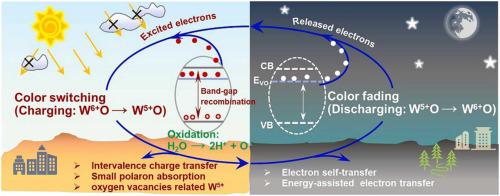Journal of Photochemistry and Photobiology C: Photochemistry Reviews ( IF 13.6 ) Pub Date : 2022-11-12 , DOI: 10.1016/j.jphotochemrev.2022.100555 Xu Dong , Yiren Lu , Xianhua Liu , Lihong Zhang , Yindong Tong

|
The reversible photochromic response of tungsten oxide (WO3) holds promise for solar-related applications as it is capable of photo charging during illumination (color-switching) and spontaneous discharging post-illumination (self-bleaching). Advances in WO3-based nanostructures synthesis via micro/nanofabrication techniques have created remarkable potential application opportunities. Smart windows represent a typical energy-saving technology; ultraviolet indicators can sense radiation safety limits, and the around-the-clock photocatalysts can be used for pollutant degradation and bacterial disinfection applications. These materials, their distinct properties, and the effects of their application must be comprehensively understood prior to commercialization. In this work, we first summarize the affiliation between the crystallographic properties-optical features-photochromic behavior of WO3. Several photochromic models and kinetic equations are then presented, accompanied by the related characterization techniques and evaluation methods. The factors affecting photochromic efficiency (e.g., light absorption, surface reaction, and carrier migration) are delineated to clarify the advantages of the specific nanostructured WO3 and the most efficient available strategies for constructing WO3-based nanomaterials. The theory, technique, and performance associated with chromogenic applications in smart devices, energy conversion, and environmental remediation are deliberated in detail. Finally, we outline the challenges and emerging trends in this area calling for further innovation to fill various gaps.
中文翻译:

纳米结构氧化钨作为用于智能设备、能量转换和环境修复的光致变色材料
氧化钨 (WO 3 ) 的可逆光致变色响应有望用于太阳能相关应用,因为它能够在照明期间进行光充电(颜色切换)并在照明后自发放电(自漂白)。WO 3的进展通过微/纳米制造技术合成基于纳米结构的纳米结构已经创造了巨大的潜在应用机会。智能窗是一种典型的节能技术;紫外线指示器可以感知辐射安全限制,全天候光催化剂可用于污染物降解和细菌消毒应用。在商业化之前,必须全面了解这些材料、它们的独特特性以及它们的应用效果。在这项工作中,我们首先总结了WO 3的晶体学性质-光学特征-光致变色行为之间的联系. 然后介绍了几种光致变色模型和动力学方程,以及相关的表征技术和评估方法。描述了影响光致变色效率的因素(例如,光吸收、表面反应和载流子迁移)以阐明特定纳米结构 WO 3的优势和构建基于 WO 3的纳米材料的最有效可用策略。详细讨论了与显色在智能设备、能量转换和环境修复中的应用相关的理论、技术和性能。最后,我们概述了这一领域的挑战和新兴趋势,呼吁进一步创新以填补各种空白。



























 京公网安备 11010802027423号
京公网安备 11010802027423号